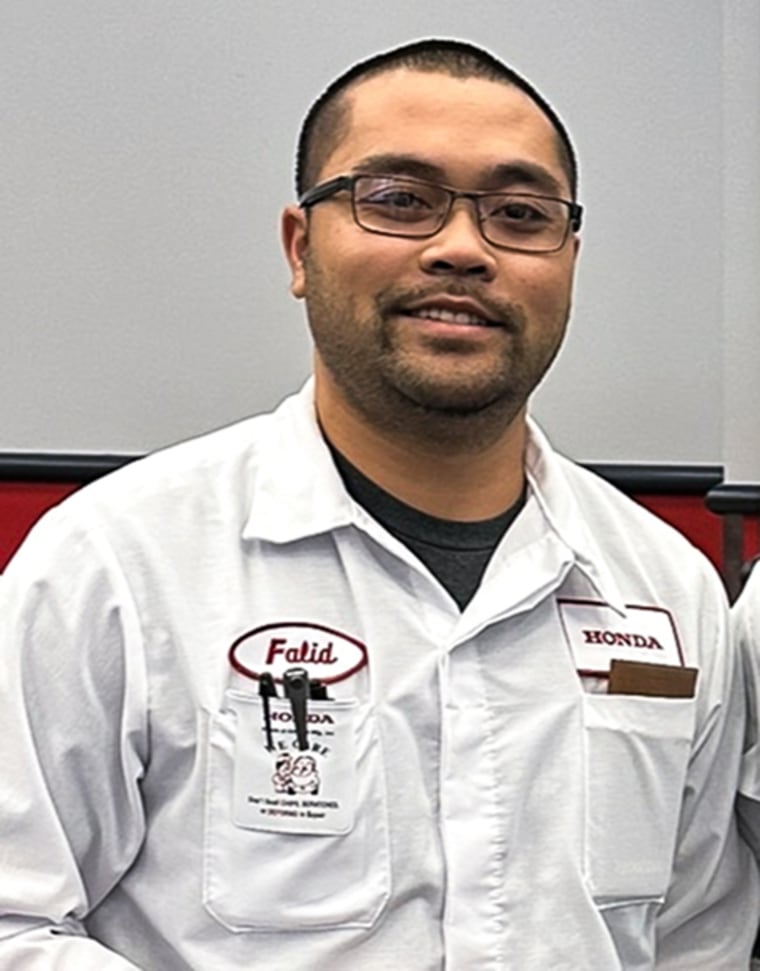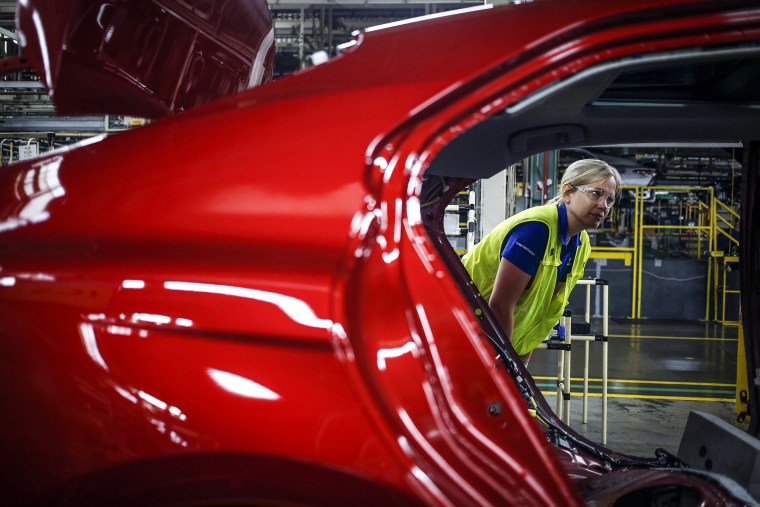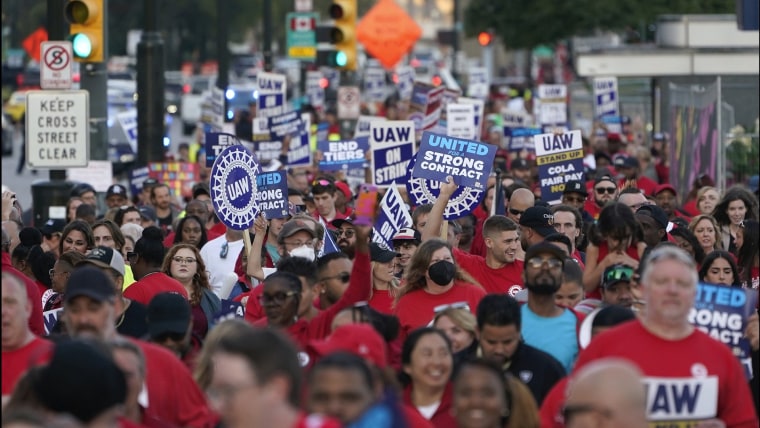It isn’t just card-carrying United Auto Workers members who are closely watching the expanding strikes at General Motors, Ford and Stellantis plants — nonunion autoworkers at rival companies are paying attention, too.
Some like what they see; others aren’t so sure.
James Bryant, a vehicle inspector at a Nissan plant in Canton, Mississippi, said he and his colleagues discuss the latest strike developments before work and during their breaks, hoping enough teammates will become galvanized to unionize their own facility.
“I think they’re doing the right thing,” Bryant, 51, said of the strikers. “If they don’t, these companies are just going to keep doing whatever it is they want to do.”
UAW President Shawn Fain had called on about 25,000 members at five plants and almost 40 parts and distributor locations to hit the picket lines starting in mid-September. Since then, many nonunion autoworkers said, they’ve been inspired by the union’s demands, including big raises and an end to tiered pay.
The Big Three are the only carmakers that employ unionized workers in the U.S. But attitudes among their rivals’ employees matter not just to the likes of Tesla, Nissan, Hyundai and Toyota — whose lower-cost workforces are a competitive advantage — but also to the UAW’s ambitions to grow its ranks on less favorable turf.
“The response from autoworkers at nonunion companies has been overwhelming,” Fain said in a statement to NBC News. “Hundreds of workers across the country, from the West to the Midwest and especially the South, are reaching out to join our movement and to join the UAW.”
The auto industry is shifting south from Detroit, with new electric vehicle and battery plants expanding across the Sun Belt and the lower Midwest. Much of the new development is occurring in conservative states with low union representation and weaker labor protections, such as “right to work” laws that let workers opt out of union participation.
Nonunion carmakers have fended off union efforts in the U.S. for years, said Kate Bronfenbrenner, director of labor education research at the Cornell University School of Industrial and Labor Relations. But the ongoing strike gives workers across the industry a high-profile chance to reconsider what the UAW may be able to deliver.
“What if they see the gains that the union was able to gain? That kind of thing changes people’s minds,” she said.
Fain said the UAW is “looking at organizing half a dozen auto companies in the coming years,” adding, “Pretty soon we won’t just be talking about the Big Three — more like the Big Five, Big Seven, Big Ten unionized automakers. We’re just getting started.”
So far, though, there’s plenty of skepticism to go around.
Bryant, a 20-year veteran at the Canton Nissan plant, which employs around 5,000 people, said many of his co-workers “just freeze up and get scared” at the prospect of unionizing. The last attempt, in 2017, was soundly defeated.
“They were told that if we got a union, the plant was going to close and move to Mexico and all these different things,” he said. “We tried, we lost and we just moved forward.”
A Nissan spokesperson said the company “respects the right of employees to determine who should represent their interests in the workplace. However, we believe our workplace is stronger without the involvement of third-party unions.”

Falid Vongasa, who works for Honda’s supply chain stability group at its plant in Marysville, Ohio, said he’s heard murmurs about organizing, including when company software reportedly shorted workers’ overtime in 2021.
But Vongasa, 32, said he has great job stability at Honda, especially after working in restaurants. He said he was promoted almost a year ago from the assembly line to an office role with a significant pay bump.
“If you’re familiar with a restaurant background, you don’t get weekends off, you don’t get medical insurance most of the time, 401(k) and all that,” he said. “I’m grateful for all that, and I’m not really expecting any more,” he said, adding that he supports the UAW strikers nonetheless.
Even workers who haven’t seen major pay gains voiced hesitancy toward organizing. Omari Roundtree, 33, is a colleague of Vongasa’s at the Maryville plant. He said his pay, which tops out at $30 per hour, hasn’t kept pace with inflation and three straight years of rent hikes of $100 a month.
“It’s really disconcerting when you’re building a $60,000 SUV and you can’t afford it,” he said. That price tag is about on par with his student loan debt, which he’s back on the hook to make payments on after a pandemic-era pause expired over the weekend.
It’s really disconcerting when you’re building a $60,000 SUV and you can’t afford it.
Omari Roundtree, Honda Plant Worker, Maryville, OHio.
Still, Roundtree — a trim specialist who installs air bags and seat belts — is wary of unions, a sentiment he inherited from his father, who worked for a GM supplier in the 1990s.
“I remember him telling me it’s kind of like you’re the little guy that’s in the arena with two pit vipers, and you’re basically trying to high-tail it out of there without getting bitten or killed,” he recalled.
Honda didn’t comment.
Already, several thousand layoffs and furloughs have been announced at the Big Three and their suppliers since the UAW strike began. Industry analysts have warned that more job cuts could follow, particularly if the eventual labor contracts require pay increases that the carmakers say would threaten their EV investments.
As nonunion autoworkers weigh those risks, many also remain leery of a UAW whose reputation Fain has tried to rebuild after a yearslong corruption scandal.
On the other hand, recent labor victories have put unions in the spotlight.
Some autoworkers, including Bryant, said they watched the UPS-Teamsters negotiations closely this summer and were encouraged by the union’s wins. After a monthslong strike, the Writers Guild of America secured conditions that surprised even some industry watchers. Americans’ attitudes toward unions have climbed, with two-thirds seeing them favorably and a growing share expecting the labor movement to strengthen, a Gallup poll in August found.
Conbralius Thomas said he and some of his colleagues “have been trying to get” the UAW down to the Hyundai assembly plant in Montgomery, Alabama, where he has worked for 11 years. He criticized the plant’s rules around paid time off and said the company hasn’t sufficiently boosted pay for taking on new responsibilities.
“I wish we were in a position where we could strike now,” said Thomas, who added that he has been involved in UAW organizing amid the union’s post-scandal restructuring.
Hyundai didn’t comment directly on unionizing efforts, but a spokesperson said the company’s “top priority is the safety and well-being of the more than 114,000 individuals we employ” and touted its more than $12 billion investments in new EV plants in Alabama and Georgia.
As Thomas sees it, “in the South, you have a lot of scared people that don’t know much about a union because they’ve been raised to be against a union.” But he said the Big Three strikes make now a “great time” for the UAW to ramp up organizing, including at nonunion plants.
“The UAW flies under the radar real stealthlike. They do it to the point where it hurts them,” he said. “If they made more noise, I think it would encourage people.”

